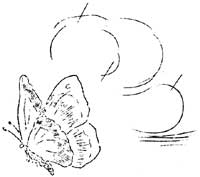
 | ||||||||
Visitors to the Park who enjoy watching the birds and mammals seldom realize that they are overlooking a group of animals, far outnumbering these more numerous forms. I refer to the insects which, sad to relate are more often brought to the attention of the tourists in an unfavorable light because of the activities of the more aggressive members of the family. True enough the mosquitoes and flies seem to have a grudge against all members of the human race, but we need not let a dislike for this small group keep us from an enjoyable study of the remaining and far larger groups of insects. By searching among the flowers, under rocks, or along the banks of streams it is possible to get an insight into the lives of many interesting insects and take pleasure not only from their curious colors and shapes but also from their activities in building their homes, getting food,etc. 
Scientists have classified the insects into about 22 groups depending largely upon the structure of their wings. Some, as the butterflies, (Lepidoptera), have large, conspicuous, many-colored wings covered with tiny scales. The beetles, (Coleoptera), have two types of wings, the front pair thick, heavy, and used as a protective covering for the hind pair which are thinner and more delicate. On the flies, (Diptera), we note but one pair of wings and behind them the tiny stubs which represent the vestiges of another pair long since disappeared from the race. In other insects we find a wide range of forms, from the dragon flies, (Odonata), the grasshoppers, (Orthoptera), to the springtails, (Aptera), found on the snowfields above Paradise. So dont step on the next bug you see. Time spent examining him is worth while.-V.Scheffer. | ||||||
| <<< Previous | > Cover < | Next >>> |
vol9-6c.htm
12-Jun-2001